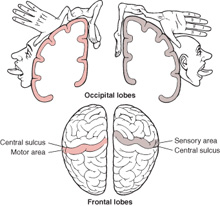 13) Larger cortical space is correlated with greater representational resolution; memories are stored in cortex (Penfield – 1957)
13) Larger cortical space is correlated with greater representational resolution; memories are stored in cortex (Penfield – 1957)
Prior to performing surgery, Wilder Penfield electrically stimulated epileptic patients' brains while they were awake. He found the motor and somatosensory strips along the central sulcus, just as was found in dogs by Fitsch & Hitzig (see previous post). The amount of cortex dedicated to a particular part of the body was proportional not to that body part's size, but to its fine control (for motor cortex) or its sensitivity (for somatosensory cortex).
Thus, the hands and lips have very large cortical spaces relative to their size, while the back has a very small cortical space relative to its size. The graphical representation of this (see above) is called the 'homunculus', or 'little man'.
Penfield also found that stimulating portions of the temporal lobe caused the patients to vividly recall old memories, suggesting that memories are transfered from the archicortical hippocampus into neocortical temporal lobes over time.
Implication: The mind, largely governed by reward-seeking behavior, is implemented in an electro-chemical organ with distributed and modular function consisting of excitatory and inhibitory neurons communicating via ion-induced action potentials over convergent and divergent synaptic connections strengthened by correlated activity. The cortex, a part of that organ whose spatial dedication determines representational resolution, is involved in perception (e.g., touch: parietal lobe, vision: occipital lobe), action (e.g., frontal lobe), and memory (e.g., temporal lobe).
[This post is part of a series chronicling history's top brain computation insights (see the first of the series for a detailed description). See the history category archive to see all of the entries.]
-MC


What happened to the hippocampus line from yesterday?
I assume you mean in the “implications” summary…
Yesterday’s insight is incorporated into “cortex”, which is now said to be “involved in perception, action, and memory“.
I’m trying to keep the summary concise, and went back and forth on whether to have an explicit reference to hippocampus in there. Ultimately, since it’s part of cortex (though not neocortex) I felt this sentence incorporated yesterday’s post while expanding it with today’s.
Let me know if you have a compelling argument for including an explicit reference to hippocampus in the summary.
I edited the implication summary to include a bit more about localization within cortex. Note that hippocampus is part of the temporal lobe of cortex (hence it is encompassed in the statement “is involved in … memory (e.g., temporal lobe)”).
It was just that every other day had simply added to the previous day’s summary, so I was used to that…
Not claiming it was wrong or anything!